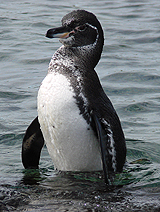Home | Tours | Trip Reports | News | Team | Calendar | Links | Contact | Store | Mailing List
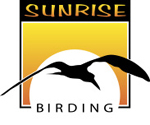 Galápagos
&
Galápagos
&
Ecuador
Trip 2: July
15 - 27, 2007
TRIP REPORT
TRIP 1: REPORT> SPECIES LIST>(PDF) PDF Report>(no photos)
TRIP 2: REPORT> SPECIES LIST>(PDF) PDF Report> (no photos)
LEADERS: Gina Nichol & Juan Carlos Calvachi
Sunday, July 15, 2007
Penny, Kris, Bernie, Ginny, Diane, and Liz flew in the previous day and spent an extra evening at El Jardin. By 6 AM this morning Penny and Kris were out birding on the lovely grounds of El Jardin. Gina joined them as the day brightened and with a bit more light we could see several Sparkling Violetears chasing each other around the 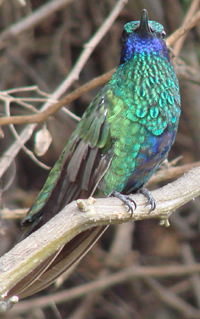 Bottlebrush trees. A Western Emerald tried to feed on the red flowers only to be chased by the aggressive Violetear. Other early birds included Rufous-collared Sparrow, Great Thrush, Eared Dove, some bright Saffron Finches, and Cinereous Conebill.
Bottlebrush trees. A Western Emerald tried to feed on the red flowers only to be chased by the aggressive Violetear. Other early birds included Rufous-collared Sparrow, Great Thrush, Eared Dove, some bright Saffron Finches, and Cinereous Conebill.
After breakfast, the early arrivals went with Norby to explore old Quito with visits to several churches and the equator monument. By the time they returned, Angel and Steve had arrived. At dinner they regaled us with their cultural adventures of the day. They had just retired for the evening when Juan arrived with the rest of the group – Amy, Ginny, John, Bob, and Charlotte. We all settled in for the night, resting up in anticipation of our next day’s birding in the Andes.
Monday, July 16, 2007
Some of us enjoyed a bit of pre-breakfast birding in the garden at El Jardin. The Sparkling Violetears were very vocal and active and we got good looks at a pair of Saffron Finches on the ground near the vegetable garden. A few Rufous-collared Sparrows worked the trees in front of the B&B and several Eared Doves flew over in all directions. A Great Thrush or two appeared in the garden and we could see a few Blue-and-White Swallows flying above as well. There was a quick look at a Cinereous Conebill. Some Hooded Siskins were a bit more cooperative. We eventually got ourselves into breakfast and it was our first meal together as a group so Juan officially welcomed us. After breakfast, we prepared for our day and while we were waiting to board the bus, a brilliant male Vermillion Flycatcher perched on the soccer goal. A female and juvenile joined it and then they all flew off together.
We boarded the bus and headed east away from Quito toward Papallacta. Norby oriented us geographically and told us about life in the countryside outside Quito. We made a stop along Papallacta Road and as we got out of the van, we could see several Carunculated Caracaras flying above a distant ridge. Juan heard a Tufted Tit-Tyrant which soon showed on the top of some nearby bushes. Then he spotted a Giant Hummingbird on a nearby hillside and scoped it but it flew before all of us got on it. We scanned the area and relocated it on another flower – a lovely male. Another Giant Hummingbird appeared in the same area, this one a female, and 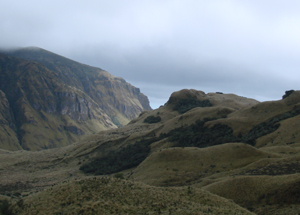 we all got good looks at the largest hummingbird in the world. While we were watching that a female Blue-and-Yellow Tanager appeared in a nearby tree. There were several
Great Thrushes around which distracted us from these less common species. Juan spotted a Variable Hawk soaring above the ridge and we studied the difference between that and the Caracaras that had gone through previously. A lone Andean Gull flew above the valley. It was distant but then four more appeared on the other side of the valley giving better looks. We had walked down the road from the bus and Wilson called down to us that he spotted an Andean Condor. We hurried back up but only Angel got to see it as it disappeared behind the ridge. We watched for it for several minutes but it did not reappear. A Band-tailed Pigeon flew up the valley and landed on top of a bush on the hillside. While we were scoping that Gina spotted a Red-crested Cotinga on top of another bush and a few of us saw it in the scope before it flew. Two more Band-tailed Pigeons flew in and perched on a closer bush giving us excellent views. The number of species in such a short time was exhilarating!
we all got good looks at the largest hummingbird in the world. While we were watching that a female Blue-and-Yellow Tanager appeared in a nearby tree. There were several
Great Thrushes around which distracted us from these less common species. Juan spotted a Variable Hawk soaring above the ridge and we studied the difference between that and the Caracaras that had gone through previously. A lone Andean Gull flew above the valley. It was distant but then four more appeared on the other side of the valley giving better looks. We had walked down the road from the bus and Wilson called down to us that he spotted an Andean Condor. We hurried back up but only Angel got to see it as it disappeared behind the ridge. We watched for it for several minutes but it did not reappear. A Band-tailed Pigeon flew up the valley and landed on top of a bush on the hillside. While we were scoping that Gina spotted a Red-crested Cotinga on top of another bush and a few of us saw it in the scope before it flew. Two more Band-tailed Pigeons flew in and perched on a closer bush giving us excellent views. The number of species in such a short time was exhilarating!
We moved on, passing a farm field where two Carunculated Caracaras were walking on the ground. They were close to the road so we all got good views of their face pattern and plumage features. Onward, we reached Papallacta Pass at 12,000 feet and descended down toward Termas Papallacta. At Termas, some of us could not resist taking advantage of the lovely hot pools while others decided to bird the area around the spa.
In the shrubs outside the spa building, we had fabulous looks at Shining Sunbeam, Viridian Metaltail, and Black Flowerpiercer. A Black-chested Buzzard-Eagle flew across the valley and went after a rabbit on the far hillside but landed out of view. A few minutes later a second Buzzard-Eagle flew down to the same spot and this one stayed visible allowing great scope views of it. We walked the parking lot for the spa where a Brazilian Rabbit fed in the grass at the edge. Penny called us over for a colorful bird that turned out to be a Spectacled 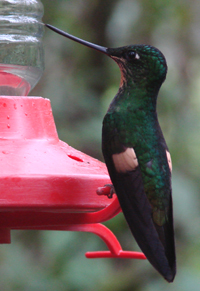 Whitestart. It stayed low in a tree for good looks and a White-banded Tyrannulet joined it. As Brown-bellied Swallows flew above us, we continued to scan the ridges for condors. Penny and John spotted a Sword-billed Hummingbird feeding on some trumpet flowers but it disappeared before the rest of us got to it.
Whitestart. It stayed low in a tree for good looks and a White-banded Tyrannulet joined it. As Brown-bellied Swallows flew above us, we continued to scan the ridges for condors. Penny and John spotted a Sword-billed Hummingbird feeding on some trumpet flowers but it disappeared before the rest of us got to it.
After an hour or so, those that went to the hot springs came out looking very relaxed and joined us to explore the temperate mountain forest behind the resort. As we stopped and got out of the van, a flock of birds was moving through the shrub line along the edge of a farm field. In it were Superciliaried Hemispingus, Agile Tit-Tyrant, Buff-winged Starfrontlet, and Blue-backed Conebill. We walked a short trail down to the Papallacta River to a lovely overlook above the rushing water. The area around the river was thick with plants. We admired a lovely orchid as well as colorful dragon mistletoe and marveled at the variety of plant life.
It was getting near lunch time so we left Papallacta and headed down to Guango Lodge. As we arrived, we were told to put blinders on and walk directly through the feeder area to lunch. Some of us caught a glimpse of a gorgeous Collared Inca in the parking lot and we began to feel the excitement of this lovely area. When we reached the lodge, to our delight, lunch was not quite ready so we spent a few minutes watching the spectacle at the feeders. Within minutes of arriving, we had seen no less than 12 species of Hummingbirds buzzing around the feeders. Tourmaline Sunangel, Chestnut-breasted Coronet, Tyrian Metaltail, Glowing Puffleg, Speckled Hummingbird, Viridian Metaltail, and the tiny, bee-like White-bellied Woodstar fed and flew in every direction around the feeders. Buff-winged Starfrontlet appeared as did several Long-tailed Sylphs with long streaming iridescent tails but the Sword-billed Hummingbird with its extended bill stole the show, eliciting a resounding “Wow!” from the crowd. A Mountain Velvetbreast joined the fray and its decurved bill helped us differentiate it from the others. Bright blue Masked Flowerpiercers appeared and added a lovely hue.
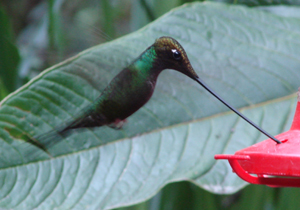 Some noise from above the feeders drew our attention to a flock of birds moving through the canopy. These included Grey-headed Bush-Tanager, Capped Conebill, and Montane Woodcreeper. The flock passed through and we were back to feeder watching. Suddenly Juan yelled “Mountain Avocetbill!” and pointed to the very front feeder. The bird was feeding right in front of us! Fantastic! Thirteen species of hummingbirds in 20 minutes! Amazing! Both excited and hungry, we had to tear ourselves away from the feeders for lunch and the lunch was indeed delicious. As we finished desert, the sun came out and a stunning Turquoise Jay appeared through the window.
Some noise from above the feeders drew our attention to a flock of birds moving through the canopy. These included Grey-headed Bush-Tanager, Capped Conebill, and Montane Woodcreeper. The flock passed through and we were back to feeder watching. Suddenly Juan yelled “Mountain Avocetbill!” and pointed to the very front feeder. The bird was feeding right in front of us! Fantastic! Thirteen species of hummingbirds in 20 minutes! Amazing! Both excited and hungry, we had to tear ourselves away from the feeders for lunch and the lunch was indeed delicious. As we finished desert, the sun came out and a stunning Turquoise Jay appeared through the window.
It was time to get back outside where we enjoyed some quality time at the feeders observing the antics of the hummingbirds. Cameras clicked like mad trying to capture the feathered gems in our midst. We experimented at how close we could actually get to the birds and found that if you stood still enough they would even land on you! It was an incredible afternoon and just a taste of birding in Ecuador. Juan told us that right now, one could see up to 65 species of hummingbirds at lodge feeders in Ecuador. We had seen 17 species today and some of us were already thinking about our next birding trip to see more of the amazing spectacle of hummingbirds in Ecuador!
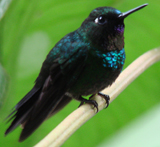 Completely satisfied with our birding experience, we boarded the bus and traveled back to El Jardin. We kept a vigilant watch for Andean Condor as we drove through the mountains but were not able to find another one. We had to settle for a nice, close American Kestrel that flew along with us for a moment as we entered Quito. When we arrived back at El Jardin, we thanked our wonderful guide Norby and excellent driver and Condor-spotter Wilson. We rested a bit before dinner and then enjoyed another wonderful meal at our B&B. After dinner, we reviewed our fantastic bird list for the day and Juan briefed us on our impending adventure in the Galápagos.
Completely satisfied with our birding experience, we boarded the bus and traveled back to El Jardin. We kept a vigilant watch for Andean Condor as we drove through the mountains but were not able to find another one. We had to settle for a nice, close American Kestrel that flew along with us for a moment as we entered Quito. When we arrived back at El Jardin, we thanked our wonderful guide Norby and excellent driver and Condor-spotter Wilson. We rested a bit before dinner and then enjoyed another wonderful meal at our B&B. After dinner, we reviewed our fantastic bird list for the day and Juan briefed us on our impending adventure in the Galápagos.
Tuesday, July 17, 2007
After breakfast, we departed from El Jardin for our flight to the Galápagos. We navigated our way through the airport, boarded the flight, and flew to Guayaquil where we saw both Great and Cattle Egrets on the airport runway. From here, we flew to the small island of Baltra, arriving in the Galapagos by late morning. We met our National Park guide, Billy, a 20-year veteran park guide. We boarded a bus for a short ride to the bay where the San Jose was waiting for us. As we arrived at the dock, a small contingent of Sea Lions greeted us (really, they were snoozing on the dock, but we liked the thought that they were welcoming us). Blue-footed Boobies were plunge diving just off the dock and we got our first looks at Magnificent Frigatebirds and Brown Noddies. A Lava Gull flew by almost unnoticed as we were still intrigued by the Sea Lions.
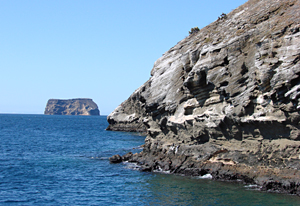 In a few minutes, the dinghy arrived to take us to the ship where we all got an official briefing from Billy about ship safety and Galápagos National Park rules. We settled quickly into our rooms and enjoyed a lovely lunch, but most of us could not sit still very long as we could see birds and islands out the windows. Soon we were up on deck and circumnavigating the island of Daphne Major, which held a variety of birds and sea creatures around its shoreline. There were many Brown Noddies fishing the shoreline waters, but our attention was quickly averted to the elegant Red-billed Tropicbirds flying above our heads. Blue-footed Boobies were sitting on the shoreline and further up toward the caldera we could see a number of Nazca Boobies. A few finches were around, too distant to identify, but we did see our first Mangrove Warbler, easily identifiable by its bright yellow color. A number of Swallow-tailed Gulls were seen perched on the ledges above the shoreline. We looked in many of the small caves and hollows and found two Lava Herons. At the shoreline hundreds of Sally Lightfoot Crabs clung to rocks while Marine Iguanas crawled up the sheer ledges.
In a few minutes, the dinghy arrived to take us to the ship where we all got an official briefing from Billy about ship safety and Galápagos National Park rules. We settled quickly into our rooms and enjoyed a lovely lunch, but most of us could not sit still very long as we could see birds and islands out the windows. Soon we were up on deck and circumnavigating the island of Daphne Major, which held a variety of birds and sea creatures around its shoreline. There were many Brown Noddies fishing the shoreline waters, but our attention was quickly averted to the elegant Red-billed Tropicbirds flying above our heads. Blue-footed Boobies were sitting on the shoreline and further up toward the caldera we could see a number of Nazca Boobies. A few finches were around, too distant to identify, but we did see our first Mangrove Warbler, easily identifiable by its bright yellow color. A number of Swallow-tailed Gulls were seen perched on the ledges above the shoreline. We looked in many of the small caves and hollows and found two Lava Herons. At the shoreline hundreds of Sally Lightfoot Crabs clung to rocks while Marine Iguanas crawled up the sheer ledges.
Leaving Daphne Major, we headed toward the north coast of Santa Cruz. During the crossing we had the change to study the pattering Elliot’s Storm-Petrel and differentiate it from Wedge-rumped Storm-Petrel. A Spotted Eagle Ray flipped out of the water and there was a report of a Manta Ray in the water.
Once anchored off Las Bachas, we took the dinghies to Bachas Beach for our first wet landing. Some of us snorkeled, while others walked the beach to check for birds. Galápagos Mockingbird and Medium Ground-finch were seen, as well as a few Marine Iguanas on the sand. A Great Blue Heron stood on the sand above some Green Sea Turtle nests and some Mangrove Finches flitted in the vegetation at the edge of the beach. There 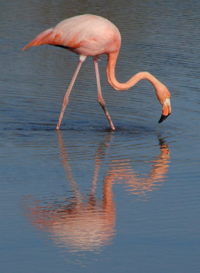 were several finches flying fast and we decided to call them “Darwin’s Finches” until we got good-enough looks to identify them. Out in the water, there were several Blue-footed Boobies plunge diving not far from the beach.
were several finches flying fast and we decided to call them “Darwin’s Finches” until we got good-enough looks to identify them. Out in the water, there were several Blue-footed Boobies plunge diving not far from the beach.
The birders were delighted to find a small lagoon with two Greater Flamingos. We enjoyed them for a few minutes and a third flew in, giving us wonderful flight and landing views. As we looked over the dune, we noticed two American Oystercatchers sleeping at the edge of the water, as well as a Whimbrel and six Ruddy Turnstones. A Semipalmated Plover was spotted in an adjacent lagoon and we all got on it with the scope.
We walked back to meet the snorkelers and took them back over to the lagoon to enjoy the flamingos. The entire cast of characters was there and we got great views of everything, in addition to five or so Smooth-billed Anis that flew in, and a lone Black-necked Stilt on the other side of the lagoon. We scanned the far edge at the waterline to find several Hermit Crabs with their oversized claw sitting on the mud. We stayed in this lovely setting until the sun began to drop in the sky, then headed back to the landing spot. Madrid brought us all back to the ship where Jefferson was waiting with a delicious snack.
After a gorgeous sunset, we gathered on the second deck to admire the crescent moon and Jupiter and have a look at the Southern Cross. The sky was clear and dark and with each moment more stars appeared. Soon the Milky Way was evident and we marveled at the beauty of the night sky. The crew began to gather in their sailor whites and we were formally introduced to them with a welcome toast. All the while, some Brown Pelicans had gathered in the water around the ship. As we watched them, we notice a large gray form swimming under the water surface, which turned out to be a Galápagos Shark. The dinner bell rang and we enjoyed a delicious meal. After dinner, Amy found an Elliot’s Storm-Petrel on the deck of the ship. It looked OK, perhaps stunned, so Gina took it to the upper deck and after a few minutes it flew away. Back in the lounge Billy briefed us on our plan for tomorrow and Juan reviewed the bird list. As we stepped out to retire to our cabins, we noticed many small fish jumping in the water with Brown Pelicans and Sea Lions chasing them. From the second deck we could see three Galápagos Sharks taking advantage of the food and decided we wouldn’t take a midnight snorkel! The stars were even more numerous now with the Summer Triangle visible, along with Cygnus the Swan, Aquila the Eagle, and Lyra the Lyre. The Big Dipper was low on the horizon as was the North Star. We enjoyed the incredible sights and went to sleep full of anticipation of our Galápagos adventures ahead.
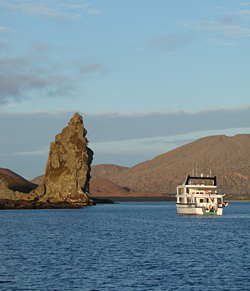 Wednesday, July 18, 2007
Wednesday, July 18, 2007
As the sun rose, the San Jose was dropping anchor just off the small island of Bartolome. Pinnacle Rock loomed above us as did the summit of Bartolome formerly known as “Heartbreaker”. We boarded the dinghy and went to the island to walk up to the summit. Just before we landed, some flying fish flew out of the water alongside us. A Lava Heron greeting us at the landing spot as well as some Sally Lightfoot Crabs clinging to the lava formations at the water’s edge. Billy pointed out the pioneer plants that were colonizing the bare lava of the island including Tiquilla, Milk plant, and Lava Cactus. A Small Ground-finch flitted in the lava and several Lava Lizards scurried along the trail as we walked. We took our group photo overlooking Pinnacle Rock. From the summit there were fantastic views in all directions and we could see 11 islands. By now, other groups were coming to the island so we headed back to the San Jose for breakfast.
As we waited to load the dinghies, a feeding flock of 40 or so Elliot’s Storm-Petrels pattered in the flat water behind the boat. A number of Galápagos Shearwaters flew by and were also feeding on the water surface. After breakfast, we took a dinghy ride around Pinnacle Rock – our goal to find Penguins. It wasn’t long before we found one in the water near the lava shoreline. As we got close we could see that the bird was preening in the water. After awhile it climbed out onto a rock and continued to preen giving us a fantastic show. Unbothered by our presence, the bird gave us front and back views of its lovely plumage and we watched for several minutes until it jumped back into the water and swam across the bay.
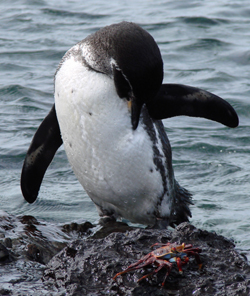 Thrilled at this spectacle, we continued on around the pinnacle where a couple of Brown Pelicans were perched atop some rock outcroppings. A Lava Heron was spotted skulking along the edge and several sea lions could be seen lounging in the rocks. A little further on, we found another Galápagos Penguin up on a rock preening and pointed it out to the second dinghy which was just catching up with us. We went all the way to Sullivan Bay where we circumnavigated a large rock which held several Blue-footed Boobies and we got our first good looks at their brilliant feet. On the way back, there was yet another Galápagos Penguin out of the water – making our count of 3 for the day! We were utterly elated!
Thrilled at this spectacle, we continued on around the pinnacle where a couple of Brown Pelicans were perched atop some rock outcroppings. A Lava Heron was spotted skulking along the edge and several sea lions could be seen lounging in the rocks. A little further on, we found another Galápagos Penguin up on a rock preening and pointed it out to the second dinghy which was just catching up with us. We went all the way to Sullivan Bay where we circumnavigated a large rock which held several Blue-footed Boobies and we got our first good looks at their brilliant feet. On the way back, there was yet another Galápagos Penguin out of the water – making our count of 3 for the day! We were utterly elated!
We made our way onto the beach below Pinnacle Rock. Some of us snorkeled while others enjoyed the beach. Some friendly Sea Lions were in the water near shore giving the snorkelers a chance to get up close and personal. The sea life around the Pinnacle was outstanding and included many sea stars, parrotfish, an octopus, and several schools of smaller fish. From the beach, Semipalmated Plover and American Oystercatcher were noted and some Medium Ground-finches and Mangrove Warblers were seen.
Back to the boat and set sail for Puerto Egas on Santiago. We sat down to another delicious lunch and had just about finished when Madrid came in to tell us that some Dolphins had been spotted in the water. We quickly filed out of the dining room to see a few fins go by and feel the boat turning around. As we turned we could see the Dolphins behind us – we were heading back to get a closer look. It was quite exciting when the pod of Dolphins approached us getting right in front of the ship and riding the bow wave. There were at least nine of these incredible animals that took turns in groups of 4 or so getting their free ride. They looked up at us leaning over the bow of the ship to see the spectacle and some jumped out of the water in front of the boat as it moved. The show was amazing! What a thrill!
After awhile, the Dolphins went off on their own and we turned back around to continue our journey. It was time for siesta for several people, while others sat on deck and caught up on their journals. Those watching the water during the crossing saw more Manta Rays, Spotted Eagle Rays jumping, several Wedge-rumped Storm-Petrels, a Dark-rumped Petrel, many Galápagos Shearwaters, Magnificent Frigatebirds that were drafting the ship. The scenery was gorgeous and we passed one large rock which held juvenile and adult Nazca Boobies.
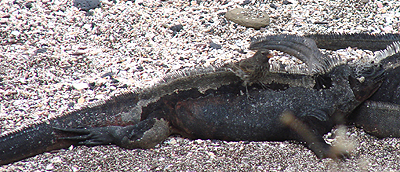 At Puerto Egas, we made a wet landing where there was a very vocal male sea lion on the beach. Amy spotted a Galápagos Mockingbird on a bush, then a Lava Heron eating young Sally Lightfoot Crabs on a rock in the water. Billy told the stories of the various failed enterprises on the island – some of which we could see the remnants. He also pointed out some of the vegetation which included Galápagos Acacia and Lantana. Juan found a Galápagos Scorpion under a rock at the side of the trail and we wondered how on earth this creature colonized this remote island. Juan pointed out a Galápagos Hawk hovering, but we were soon distracted from that by the large Marine Iguanas on the shore. A Small Ground-finch picked at the skin of some of the Marine Iguanas and we reckoned that it was removing ectoparasites.
At Puerto Egas, we made a wet landing where there was a very vocal male sea lion on the beach. Amy spotted a Galápagos Mockingbird on a bush, then a Lava Heron eating young Sally Lightfoot Crabs on a rock in the water. Billy told the stories of the various failed enterprises on the island – some of which we could see the remnants. He also pointed out some of the vegetation which included Galápagos Acacia and Lantana. Juan found a Galápagos Scorpion under a rock at the side of the trail and we wondered how on earth this creature colonized this remote island. Juan pointed out a Galápagos Hawk hovering, but we were soon distracted from that by the large Marine Iguanas on the shore. A Small Ground-finch picked at the skin of some of the Marine Iguanas and we reckoned that it was removing ectoparasites.
Offshore there was a good-sized feeding flock of Common Noddies, Brown Pelicans, and Blue-footed Boobies. Magnificent Frigatebirds were in hot pursuit, stealing any catches that they could, and Brown Noddies stood on the heads of the Pelicans stealing their catches.
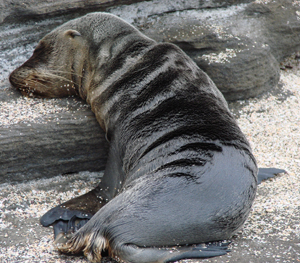 We walked the trail along the beach where Galápagos Mockingbirds were common and we got close to some sleeping American Oystercatchers and saw several Green Sea Turtles just offshore. At one point, we passed a very small Sea Lion pup and Billy explained that it was probably not abandoned and just waiting for its mother to return. Further on, Ginny spotted a Galápagos Hawk perched in a tree and as we looked around there were no less that four Galápagos Hawks in trees around the island. Two Whimbrels were spotted on a distant rock and we all got good looks at them in the scope.
We walked the trail along the beach where Galápagos Mockingbirds were common and we got close to some sleeping American Oystercatchers and saw several Green Sea Turtles just offshore. At one point, we passed a very small Sea Lion pup and Billy explained that it was probably not abandoned and just waiting for its mother to return. Further on, Ginny spotted a Galápagos Hawk perched in a tree and as we looked around there were no less that four Galápagos Hawks in trees around the island. Two Whimbrels were spotted on a distant rock and we all got good looks at them in the scope.
We arrived at Fur Sea Lion grotto where there several of these rare creatures lounging and frolicking in the water. A Yellow-crowned Night-Heron was perched on the ledge of the grotto as were many Marine Iguanas. A Green Sea Turtle entered the grotto giving us amazingly close looks and a second one joined it. Cameras clicked continuously to try to capture this amazing sight.
We started to head back and just off the lava a nice Galápagos Dove perched atop a rock for all to see. A Galápagos Flycatcher came in as well and we were racking up the species. We made our way through the inland trail which gave us the opportunity to get close to some of the Galápagos Hawks. It was beginning to get dark so we headed back to the black sand beach and took the dinghies back to the ship.
After another great dinner, we reviewed the species list and tried to identify some of the sea creatures we had seen while snorkeling. Some of us went to the upper deck to take in the incredible night sky and try to identify some of the southern constellations. The Milky Way was evident and seemingly endless.
At 9 PM several of us went to the bridge to commemorate the northward equatorial crossing. At the equator’, Johnny, who was piloting the boat, rang the ship bell and we celebrated the moment of crossing. A gorgeous crescent moon lit the sea surface and once again the sky was glittering with stars. The Milky Way was very obvious and the Southern Cross lay sideways on the horizon. It was a magical night, the perfect end to a superb day.
Thursday, July 19, 2007
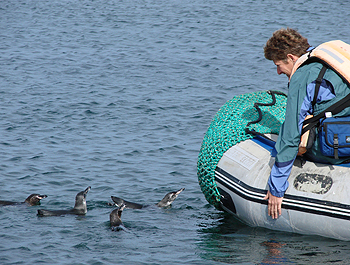 In the morning, we were anchored off Playa Tortuga Negra on Isabela. As we approached the beach for a wet landing, a group of five curious Galápagos Penguins approached the dinghies. They splashed and called to each other around us and we were delighted with this greeting to the island.
In the morning, we were anchored off Playa Tortuga Negra on Isabela. As we approached the beach for a wet landing, a group of five curious Galápagos Penguins approached the dinghies. They splashed and called to each other around us and we were delighted with this greeting to the island.
We walked to the edge of the beach along the mangrove forest. Our quarry here was the very rare Mangrove Finch which is restricted to a few small sites on Isabela. It was very quiet here until the Galápagos Mockingbirds started chattering. A Small Ground-finch was spotted in a low shrub and a Small Tree-finch flew in giving us a chance to start studying and comparing the beaks. A male Medium Ground-finch showed with its dark plumage and we spotted a juvenile Yellow-crowned Night-Heron tucked under the mangroves. Liz saw a Dark-billed Cuckoo which flew off before anyone else could see it. We searched long and hard and gave it our best effort but dipped on the Mangrove Finch. Juan wanted to continue searching but we had to get back to the boat for breakfast and keep to our navigational schedule.
Back on board, the San Jose pulled anchor and moved across the Bolivar Channel to Fernandina Island. During breakfast we were called out for a Short-finned Pilot Whale passing us in the channel. Our fabulous Captain turned the boat around so that we could watch the whale as it traveled down the channel. We saw it blow several times and at one point it came out of the water very close to the ship giving us all a thrill!
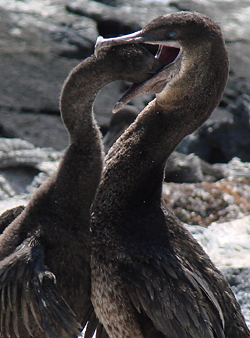 The sky was clearing as we anchored off Punta Espinoza on Fernandina and as soon as the anchor was set, we went ashore. As we approached in the dinghies, we could see several large Marine Iguanas swimming in the water and feeding on green algae exposed at low tide.
A Galápagos Hawk flew over and as we began walking on the trail it came back around calling loudly. A Striated Heron called and took flight as well as we made our way around the basking Marine Iguanas along the trail. The trail led to a Flightless Cormorant colony with many young cormorants in nests. We watched the spectacle of the colony for a long time as parents tended to their young. At one point, a persistent juvenile tried to feed by putting its head down the adult’s throat and ended up pulling out a partially digested octopus. We were amazed at the sight of the creature that had already been swallowed by the adult and then pulled out of the adult’s crop by the youngster. It was gross and amazing at the same time!
The sky was clearing as we anchored off Punta Espinoza on Fernandina and as soon as the anchor was set, we went ashore. As we approached in the dinghies, we could see several large Marine Iguanas swimming in the water and feeding on green algae exposed at low tide.
A Galápagos Hawk flew over and as we began walking on the trail it came back around calling loudly. A Striated Heron called and took flight as well as we made our way around the basking Marine Iguanas along the trail. The trail led to a Flightless Cormorant colony with many young cormorants in nests. We watched the spectacle of the colony for a long time as parents tended to their young. At one point, a persistent juvenile tried to feed by putting its head down the adult’s throat and ended up pulling out a partially digested octopus. We were amazed at the sight of the creature that had already been swallowed by the adult and then pulled out of the adult’s crop by the youngster. It was gross and amazing at the same time!
We continued on the trail passing two Lava Herons and stopping to watch two Lava Lizards fighting. The tide pools held several Green Sea Turtles and we were beginning to see how common they were. We walked around to a mangrove area where there were several more Green Sea Turtles partially submerged in the low tide. In the afternoon, we took a dinghy ride to another mangrove area along the shore. Several Flightless Cormorants were feeding in the open water offshore from another Flightless Cormorant nesting area. A Galápagos Hawk flew over as we approached the shoreline. There were several large specimens of Lava Cactus up on the rocks.
Johnny and Madrid navigated into a small lagoon, where two Galápagos Penguins were standing on a lava formation giving incredibly close looks. There were more Penguins swimming in the water as well as two Spotted Eagle Rays, two Smooth-tailed Mobulas, and several Green Sea Turtles. Kris spotted a Mangrove Warbler 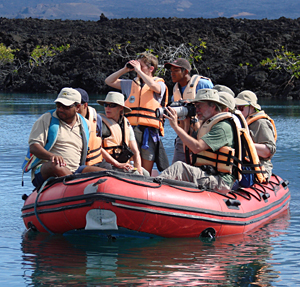 working the edge of the lava but our attention was diverted again by a young Sea Lion performing in the water around the dinghies. We passed by a Great Blue Heron under some mangroves and got close looks at a
working the edge of the lava but our attention was diverted again by a young Sea Lion performing in the water around the dinghies. We passed by a Great Blue Heron under some mangroves and got close looks at a
Lava Heron walking along the edge of the water.
After the dinghy ride, the San Jose pulled anchor and we headed toward Urbina Bay. The sun was setting over Fernandina, creating an awesome sky. We gathered at the bar to celebrate the day and after our nightly briefing we enjoyed another fantastic dinner.
Friday, July 20, 2007
This morning we woke up early in Urbina Bay on the west side of Isabela. We went to shore before breakfast to have the area to ourselves before 100 passengers from another ship landed. The beach was black sand and steep with many Green Sea Turtle nests at the top of it.
There were finches all around in the shrubs off the beach as well as Mangrove Warblers and a few Galápagos Mockingbirds. We entered the trail and immediately found two Smooth-billed Anis perched atop a tree. In a tree further off the trail was a Galápagos Hawk.
Along the trail, we were able to compare Small and Medium Ground-finches at close range and were starting to get a handle on sorting these birds out. Just as we were getting comfortable with these, a Small Tree-finch joined the mix giving us a new challenge. Though the island was very dry, there was thick vegetation and Billy pointed out Muyuyu and Galápagos Cotton. There were several Galápagos Bees buzzing around some small yellow flowers and a few Spot-winged Glider dragonflies around as well.
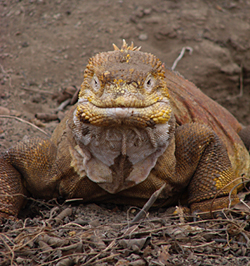 The Galápagos Hawk started to be very vocal drawing our attention to a large tree in the distance that held what looked like a large nest. We scoped it and indeed it was a nest with a young hawk in it. A little further on, we spotted our first of five Land Iguanas on the side of the trail. A Galápagos Flycatcher gave good views just off the trail.
The Galápagos Hawk started to be very vocal drawing our attention to a large tree in the distance that held what looked like a large nest. We scoped it and indeed it was a nest with a young hawk in it. A little further on, we spotted our first of five Land Iguanas on the side of the trail. A Galápagos Flycatcher gave good views just off the trail.
We came to a large open area where a few of us got a quick glimpse of a Dark-billed Cuckoo as it flew to the far end and landed on a branch, then continued into the thicket. A female Vermillion Flycatcher was much more cooperative and we all got good looks at it in the open. Juan pointed out a Cactus Finch that had landed in a tree right next to us and we were able to study the features of its bill. We continued on the trail passing another Land Iguana near its burrow, a good photo opp.
Another cuckoo was spotted, this one more cooperative as it sat for scope views for a few minutes. We also found both Large Ground-finch and Large Tree-finch and enjoyed another opportunity to compare the species.
As we made our way back along the trail, we were starting to hear voices around us and realized that we no longer had the area to ourselves. As we neared the beach, we passed one large group after another from the big ship. It felt as though the quiet island had been invaded. It was time for us to go back to the San Jose for breakfast.
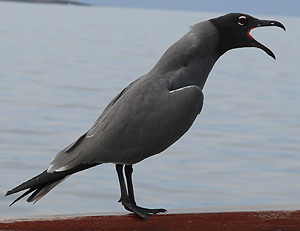 During breakfast we noticed we had taken on two more passengers – two Lava Gulls had made themselves at home on the railing of the ship. They moved up to the bow of the ship and cooperated for several pictures until our attention was diverted by an approaching pod of Bottle-nosed Dolphins. We all watched from deck as the Dolphins headed straight for us and then dove under the ship. Thrilling!
During breakfast we noticed we had taken on two more passengers – two Lava Gulls had made themselves at home on the railing of the ship. They moved up to the bow of the ship and cooperated for several pictures until our attention was diverted by an approaching pod of Bottle-nosed Dolphins. We all watched from deck as the Dolphins headed straight for us and then dove under the ship. Thrilling!
The water was flat calm and we were able to see all manner of sea creatures including more Dolphins, Green Sea Turtles, Manta Rays, the common Elliot’s Storm-Petrels, and a few Madeiran Storm-Petrels. Some of us worked our way to the comfortable chairs on the rear upper deck but it wasn’t long before Juan came back to tell us that a whale had been sighted. Once again we rushed up to the bow to see a Bryde’s Whale swimming up Bolivar Channel. Madrid was driving the ship and turned it around so that we could follow the whale. It spouted several times and gave us good looks as it swam. We watched it go off into the distance and then turned around to continue our journey to Punta Moreno.
We arrived at Punta Moreno after lunch. Some people went snorkeling in Madrid’s dinghy while others took a dinghy ride along the shore with Johnny. The dinghy ride yielded a group of Galápagos Penguins in the water as well as two on shore, Blue-footed Boobies, a few enormous Marine Iguanas, Green Sea Turtles, a small colony of Flightless Cormorants nesting, several Brown Pelicans nesting, and a Wandering Tattler – a new species for the trip.
The snorkelers had their own thrills with Green Sea Turtles and Flightless Cormorants as well as countless fish. At one point, “Magnificent Madrid” attempted a memorable rescue of a piece of lost snorkeling equipment. The snorkelers returned to the ship, elated with their experience, and with good stories to tell.
Our next excursion was ashore at Punta Moreno. We navigated into a mangrove lagoon for a dry landing and then climbed up to the trail. The sprawling lava field looked, as John put it, “primordial” and we marveled at the miles and miles of rough lava from an eruption that happened 200 years ago. We negotiated the trail noticing a number of Magnificent Frigatebirds swooping down in the distance or flying up and shaking in mid-air. The trail passed an oasis area thick with vegetation that held Common Moorhen, Medium Ground-finch, Mangrove 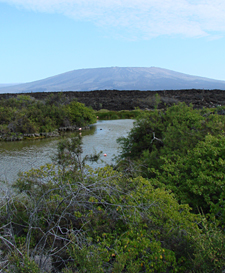 Warbler. Penny noticed a small bird running across an open area at the far end of the water which turned out to be a Semipalmated Plover.
Warbler. Penny noticed a small bird running across an open area at the far end of the water which turned out to be a Semipalmated Plover.
We continued on to another oasis where there were several Greater Flamingos feeding. A Cattle Egret flew out of the area almost unnoticed as we marveled at the beautiful pink birds in the oasis in the middle of a lava field. This was also where the Magnificent Frigatebird activity was and it turned out that the birds were swooping down to the water surface and then flying up and shaking off – we surmised that the purpose of this was to bathe, or perhaps they were picking up something to eat from the water surface. We noticed some Common Moorhens in the lagoon as well. As we were getting good looks at these, Juan shouted; “Martin” as two Galápagos Martins flew over. We all got good looks at them.
Back to the lagoon, Amy spotted a Black-necked Stilt and we all got on it. A second Stilt appeared from the left, along with more Moorhens in the far end of the lake. Juan and Bob noted a Pied-billed Grebe at the far end of the lake but it disappeared before everyone saw it and was not seen again. We continued along the trail around the lagoon and some of us tried to capture this bizarre scene on film while others marveled at the contrasts. The trail looped around to a large grotto where two White-tipped Reef-Sharks were circling as well as some large Grey Grunts and some large Puffer Fish.
The sun was beginning to set as the dinghies came to retrieve us on the island. Some flocks of Blue-footed Boobies passed us as we drove off into the sunset and a large group of very curious Galápagos Penguins approached the boats giving us all a thrill. When we got back to the San Jose, Jimmy, the chef, had prepared a special snack of lobster for us – icing on the cake for this glorious day.
Saturday, July 21, 2007
Our alarm clock this morning was the anchor of the San Jose dropping in Puerto Villamil bay on Isabela. As the sun rose, we were treated to a feeding frenzy of at least 100 Blue-footed Boobies not far from the boat. What a way to start the day!
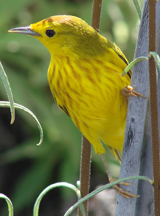 After breakfast we headed to shore and spent a few minutes in town making phone calls before we boarded a bus to take us to the highlands. As we ascended we passed from the arid zone through some fruit plantations. There were many finches along the road in addition to Dark-billed Cuckoos, Smooth-billed Anis, and some Vermillion Flycatchers. We stopped at the check-in station for Volcan Sierra Negra where we saw several Cattle Egrets, a nice Vermillion Flycatcher, and a Whimbrel. Further on, we parked the bus and hiked up to the caldera of the volcano which had erupted less than two years earlier. Juan surveyed the trails and saw that the caldera was clear so we hiked the short trail up to the top. Some of us got close views of a Warbler Finch along the way. At the top, the view was spectacular and we could see clear across the five-mile caldera. A few Small Tree- and Small Ground-finches popped up now and then as did some Mangrove Warblers. A Woodpecker Finch flew in and perched for a quick second but disappeared before most were able to get on it. While we were checking out some steam vents, a Galápagos Flycatcher landed right in front of us giving great views.
After breakfast we headed to shore and spent a few minutes in town making phone calls before we boarded a bus to take us to the highlands. As we ascended we passed from the arid zone through some fruit plantations. There were many finches along the road in addition to Dark-billed Cuckoos, Smooth-billed Anis, and some Vermillion Flycatchers. We stopped at the check-in station for Volcan Sierra Negra where we saw several Cattle Egrets, a nice Vermillion Flycatcher, and a Whimbrel. Further on, we parked the bus and hiked up to the caldera of the volcano which had erupted less than two years earlier. Juan surveyed the trails and saw that the caldera was clear so we hiked the short trail up to the top. Some of us got close views of a Warbler Finch along the way. At the top, the view was spectacular and we could see clear across the five-mile caldera. A few Small Tree- and Small Ground-finches popped up now and then as did some Mangrove Warblers. A Woodpecker Finch flew in and perched for a quick second but disappeared before most were able to get on it. While we were checking out some steam vents, a Galápagos Flycatcher landed right in front of us giving great views.
We hiked back down and headed back toward town noting at least six Vermillion Flycatchers along the way. Billy knew of a side road that went past a gravel pit that had some water in it and we stopped to scope a flock of  Galápagos Pintails in the water. Common Moorhens were also here, as well at three Black-necked Stilts and a Semipalmated Plover. Penny pointed out our first Great Frigatebird (a female) of the trip and Gina spotted a Great Egret flying over as we were about to leave the area. We took the back way into town passing a lagoon with five Greater Flamingos.
Galápagos Pintails in the water. Common Moorhens were also here, as well at three Black-necked Stilts and a Semipalmated Plover. Penny pointed out our first Great Frigatebird (a female) of the trip and Gina spotted a Great Egret flying over as we were about to leave the area. We took the back way into town passing a lagoon with five Greater Flamingos.
We stopped in town again for more phone calls and chocolate and coke supplies. Then we met back at the town dock where Bob spotted some baby Marine Iguanas and a Whimbrel out on the beach. We went back to the San Jose for lunch. It was a gorgeous afternoon and we were surrounded by turquoise water. Angel and Diane could not resist the opportunity for a swim around the boat while others of us took a dinghy ride after lunch. We surveyed a large group of Blue-footed Boobies perched on some lava and then made our way toward the mangroves. Gina and Bob spotted a lone Black-bellied Plover feeding on the edge of a small lava island. We landed at Las Tintoreras and walked a trail through some rough lava to a bridge over an inlet which held at least 20 White-tipped Reef Sharks. We were amazed at how small the area was and how many sharks were there and Billy explained that the sharks were attracted by fresh water that filtered through the unique lava formations here. On the other side was a lagoon that had two Spotted Eagle Rays and we were able to get close looks at them. There were many baby Marine Iguanas along the trails and clinging to the rocks and we imagined their fates if they fell into the shark pools. We enjoyed our visit to this unique place and made our way back to the dinghies. As we headed toward the San Jose, we encountered another feeding frenzy of Blue-footed Boobies, this time at least 1,000 to perhaps 1,500 boobies flying and plunge diving all around us. Large groups would take off from the water and circle up only to drop like bullets into the water. It was incredible to be in the middle of this spectacle and we were simply in awe of the amazing sights around us.
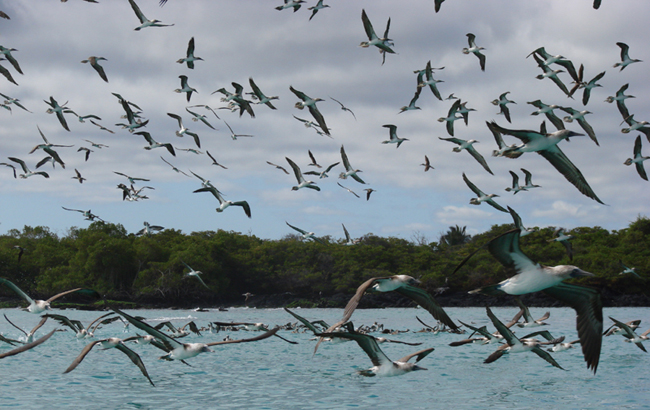
By late afternoon, we pulled anchor and set off on the long journey to San Cristobal on the eastern side of the archipelago.
Sunday, July 22, 2007
At dawn we were anchored in the harbor at Puerto Baquerizo Moreno, the provincial capital of the Galápagos on San Cristobal Island. We went ashore in the dinghies and took a bus into the highlands. We passed several Chatham Mockingbirds along the road as well as several Smooth-billed Anis and a couple of Cattle Egrets. We arrived on the east side of the island at the Cerro Colorado Tortoise Conservation Center – a captive breeding 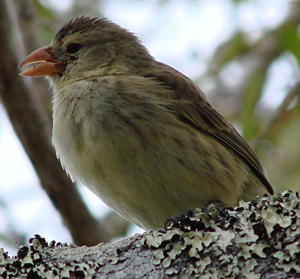 facility for the San Cristobal subspecies of Galápagos Giant Tortoise. Built to the National Park Service, the Center has an interpretive center and a natural area where the tortoises roam and breed. As we entered through the gate, we got our first good look at a Chatham (San Cristobal) Mockingbird perched atop the main building. At the entrance to the trail we got excellent looks at a Vegetarian Finch that came into a tree above our heads. We walked the main trail to a man-made pool which had several tortoises around it. Billy told us how the rearing program worked and the survival challenges faced by the tortoises, while we took advantage of some great photo opportunities. Further up the trail, we got good looks at the San Cristobal subspecies of Warbler Finch. As we made our way around to the incubation building and acclimation yards, Gina spotted two Woodpecker Finches in a tree just off the trail. The birds moved to a tree across the trail giving good views to all and showing us the behavior that earned them their name by pecking and peeling at the bark of the trees. We got to see the young tortoises that were being held in pens until they were large enough to survive on their own. Some were three months old and others were almost three years old. It was a thrill to see such small versions of the large ones we had seen on the trail. We spent some quality time with the tortoises and were filmed by a television crew. By late morning it was time to head back to port where we had a few minutes to pick up supplies, make phone calls, and shop. Charlotte was thrilled to see a parade coming through town, which appeared to be a religious celebration, so she got to witness the Galápagos version of Sunday services. It was time to get back to the San Jose so we gathered at the town dock where our faithful dinghy drivers picked us up to take us back to the boat. On board we enjoyed an early lunch and settled in for the crossing to Espanola island in the southeast corner of the Galápagos archipelago. Many of us took the opportunity to rest up for the afternoon activities during the crossing.
facility for the San Cristobal subspecies of Galápagos Giant Tortoise. Built to the National Park Service, the Center has an interpretive center and a natural area where the tortoises roam and breed. As we entered through the gate, we got our first good look at a Chatham (San Cristobal) Mockingbird perched atop the main building. At the entrance to the trail we got excellent looks at a Vegetarian Finch that came into a tree above our heads. We walked the main trail to a man-made pool which had several tortoises around it. Billy told us how the rearing program worked and the survival challenges faced by the tortoises, while we took advantage of some great photo opportunities. Further up the trail, we got good looks at the San Cristobal subspecies of Warbler Finch. As we made our way around to the incubation building and acclimation yards, Gina spotted two Woodpecker Finches in a tree just off the trail. The birds moved to a tree across the trail giving good views to all and showing us the behavior that earned them their name by pecking and peeling at the bark of the trees. We got to see the young tortoises that were being held in pens until they were large enough to survive on their own. Some were three months old and others were almost three years old. It was a thrill to see such small versions of the large ones we had seen on the trail. We spent some quality time with the tortoises and were filmed by a television crew. By late morning it was time to head back to port where we had a few minutes to pick up supplies, make phone calls, and shop. Charlotte was thrilled to see a parade coming through town, which appeared to be a religious celebration, so she got to witness the Galápagos version of Sunday services. It was time to get back to the San Jose so we gathered at the town dock where our faithful dinghy drivers picked us up to take us back to the boat. On board we enjoyed an early lunch and settled in for the crossing to Espanola island in the southeast corner of the Galápagos archipelago. Many of us took the opportunity to rest up for the afternoon activities during the crossing.
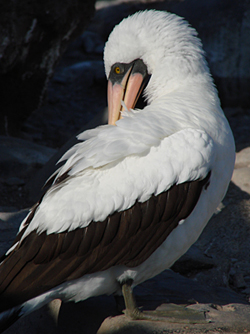 By 3 PM, we were anchored off Punta Suarez at Espanola and we took the dinghies ashore to investigate the island. The surf was rolling in, but our expert dinghy drivers got us to the dry landing site without incident. We walked up a dock to the beginning of the beach where several Marine Iguanas were swimming into shore and climbing up on the rocks or sand to get into their sunning positions. As their skin dried, patches of red color on their skin became evident. Further up the trail a squadron of Hood Mockingbirds greeted and inspected us. Three of them were gathered around a bottle cap that had been left by a previous visitor. When Billy picked it up to dispose of it, the three Mockingbirds followed him back to where the group was waiting. Were they annoyed that their toy had been taken away?
By 3 PM, we were anchored off Punta Suarez at Espanola and we took the dinghies ashore to investigate the island. The surf was rolling in, but our expert dinghy drivers got us to the dry landing site without incident. We walked up a dock to the beginning of the beach where several Marine Iguanas were swimming into shore and climbing up on the rocks or sand to get into their sunning positions. As their skin dried, patches of red color on their skin became evident. Further up the trail a squadron of Hood Mockingbirds greeted and inspected us. Three of them were gathered around a bottle cap that had been left by a previous visitor. When Billy picked it up to dispose of it, the three Mockingbirds followed him back to where the group was waiting. Were they annoyed that their toy had been taken away?
We walked through a small beach area noting Magnificent Frigatebirds, Nazca Boobies, Blue-footed Boobies, and many vocal Red-billed Tropicbirds in the air above us. There were several Sea Lions on the beach and one that moved out of the water and went directly to Kris’s feet for whatever reason. We continued along the beach to the trail noting a Galápagos Hawk that was perched on the light tower we had just passed. A Warbler Finch, the first of many, showed well on top of a bush as we entered the trail. There were a few Blue-footed Boobies involved in various activities as we walked along the trail including dancing, sky-pointing, and resting. We enjoyed the show from a short distance and then realized that the birds were not at all bothered when we passed close by. We were able to study the male/female differences as well as see them in their courtship behavior. Stunning!
We walked a trail with the sea on one side and some green vegetation on the other. On the shore side, there were a number of Nazca Boobies as well as Swallow-tailed Gulls which looked like they were also involved in nesting activities. On the interior side of the trail, several finches flew around, mostly Small and Medium Ground and a few of us were vigilant in attempting to find Large Cactus-finch as well. We passed by a Marine Iguana nesting area and stopped to look seaward in time to see a Ruddy Turnstone perched atop a large rock and a Yellow-crowned Night-Heron hunkered down under a large lava ledge.
We walked up to an open flat area where there were some nests of Blue-footed Boobies with young. The fluffy white down of the young birds looked to some like cotton candy. A few steps further we found a Waved Albatross nest with one very young downy chick, this one looking like gray cotton candy. A pair of Waved Albatross approached the trail from the other side and at one point we had to step back to allow them to pass. Their stroll by the Blue-footed Booby nest caused quite a response from the adult Booby and they were essentially run off by the Booby. When they reached the other side of the trail, they began their courtship display which included bill clacking and dancing and we were thrilled to be able to observe this unique behavior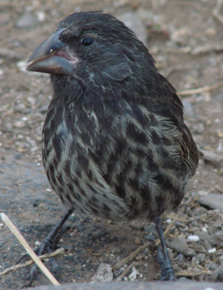 so closely! What a show! We watched and photographed for several minutes until Billy motioned us to move on as the sun was beginning to set. Steve spotted a Galápagos Hawk perched on a rock and was thrilled to have such a rare and unique species as the first bird he officially spotted. We made our way to the famous blowhole which also put on a spectacular show. As we walked there were Albatross and Boobies everywhere, giving us a glimpse into their daily life on the island which mostly had to do with courtship and rearing of young. There were spectacular views from the edge of the cliff but it didn’t take long for a disturbance to draw our attention away from the view to the side of the trail where at least a half-dozen Hood Mockingbirds were involved in an altercation which turned out to be over food. Some of the birds were excavating grubs out of the soil between the lava rocks. As soon as a bird pulled one out, the others attacked and fought over the grub, pulling it apart and gulping it quickly. Some of the altercations were quite aggressive and resulted in an action show of a different kind. We made a turn on the trial to cut across the island and to our delight a Large Cactus-finch was feeding on the ground and in a low bush right at the junction of the trail. You couldn’t ask for a better photo opp of the 10th Darwin’s Finch we had seen. Cameras clicked and we only needed to turn around to see several pairs of Waved Albatross involved in all kinds of courtship rituals. Wow!
so closely! What a show! We watched and photographed for several minutes until Billy motioned us to move on as the sun was beginning to set. Steve spotted a Galápagos Hawk perched on a rock and was thrilled to have such a rare and unique species as the first bird he officially spotted. We made our way to the famous blowhole which also put on a spectacular show. As we walked there were Albatross and Boobies everywhere, giving us a glimpse into their daily life on the island which mostly had to do with courtship and rearing of young. There were spectacular views from the edge of the cliff but it didn’t take long for a disturbance to draw our attention away from the view to the side of the trail where at least a half-dozen Hood Mockingbirds were involved in an altercation which turned out to be over food. Some of the birds were excavating grubs out of the soil between the lava rocks. As soon as a bird pulled one out, the others attacked and fought over the grub, pulling it apart and gulping it quickly. Some of the altercations were quite aggressive and resulted in an action show of a different kind. We made a turn on the trial to cut across the island and to our delight a Large Cactus-finch was feeding on the ground and in a low bush right at the junction of the trail. You couldn’t ask for a better photo opp of the 10th Darwin’s Finch we had seen. Cameras clicked and we only needed to turn around to see several pairs of Waved Albatross involved in all kinds of courtship rituals. Wow!
The sun was getting low now so we made our way back to the shoreline. We got great looks at a pair of Galápagos Hawks – one on a nest and the other keeping watch from some low rocks along the trail. We were also grateful for the good looks we got at the lovely Galápagos Doves that were working this part of the trail. We made it back to the beach and our pick-up spot where we had a mostly dry embarkation. Back at the boat, Jimmy the chef had made some excellent pizzas that we all enjoyed as our welcome-back snack. A quick few minutes to freshen up and it was time for dinner. Post dinner, we had our daily briefing by Billy and then Juan called the bird list. We all agreed that it had been a stellar day and reflected that each day so far had been fantastic!
Monday, July 23, 2007
This morning we were anchored just off Isla Champion near Floreana. As the sun rose, we assembled on the upper deck to search the island from the ship for the rare Floreana Mockingbird. The captain skillfully and slowly circumnavigated the island while we scanned the landscape for the bird. The usual Blue-footed and Nazca Boobies were around as were Swallow-tailed Gulls, Common Noddies, Brown Pelicans, Magnificent Frigatebirds, a feeding group of Galápagos Shearwaters, and a number of finches and Mangrove Warblers. Juan spotted a Floreana Mockingbird on a small beach but we were not able to get on it. So we continued to move around and survey the island. Gina spotted another on the ground near some tree cactus trunks and we were able to get on it with the scope. Several more were spotted and scoped and we were close enough for John and Bob to get halfway decent photographs. By the time the breakfast bell rang, we had seen at least six of these little beauties and were elated at our success so early in the morning. After all, this IS Sunrise Birding!
 After breakfast we went ashore at Puerto Ibarra where we took an open bus into the highlands. Penny wanted to drive but the local driver took over at the last minute. Along the way we passed at least a dozen Smooth-billed Anis, several Cattle Egrets, many Small and Medium Ground-finches, and some Mangrove Warblers. At the end of the road, we took a walking trail up the side of a hill to an area where the Wittmers had originally settled near some caves. Billy told an excellent version of the “Galápaghost” story and we marveled at the strange lives of the islands’ early residents. We explored the caves and some stone sculptures overlooking the valley below. It was time to find the Medium Tree-finch so we walked back down the trail, passing a Giant Tortoise enclosure with a few residents. Back on the main road, we climbed on to the bus which took us a mile or two and then dropped us on the road to find our quarry. Within a few minutes a Medium Tree-finch appeared on a tree branch only to disappear quickly. Then Gina spotted one with a leg band and we all got great looks at it. We had just nailed our 11th Darwin’s Finch and some of us had the photos to prove it.
After breakfast we went ashore at Puerto Ibarra where we took an open bus into the highlands. Penny wanted to drive but the local driver took over at the last minute. Along the way we passed at least a dozen Smooth-billed Anis, several Cattle Egrets, many Small and Medium Ground-finches, and some Mangrove Warblers. At the end of the road, we took a walking trail up the side of a hill to an area where the Wittmers had originally settled near some caves. Billy told an excellent version of the “Galápaghost” story and we marveled at the strange lives of the islands’ early residents. We explored the caves and some stone sculptures overlooking the valley below. It was time to find the Medium Tree-finch so we walked back down the trail, passing a Giant Tortoise enclosure with a few residents. Back on the main road, we climbed on to the bus which took us a mile or two and then dropped us on the road to find our quarry. Within a few minutes a Medium Tree-finch appeared on a tree branch only to disappear quickly. Then Gina spotted one with a leg band and we all got great looks at it. We had just nailed our 11th Darwin’s Finch and some of us had the photos to prove it.
We continued down the road and were dropped off at the Hotel Wittmer. Some of us enjoyed the museum with its many historical displays while others sat outside the hotel and relaxed overlooking a black sand beach with the San Jose the only passenger ship in view in the harbor. As lunch time approached, we went back to the 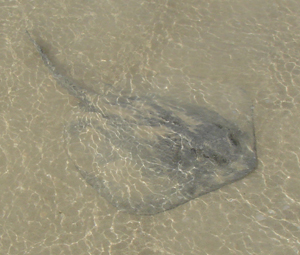 ship. We pulled anchor and headed around to Punta Cormoran, our destination for the afternoon. We had a bit of time for siesta and then some of us took the last opportunity to snorkel around Devil’s Crown. The strong current was a challenge but we still managed to see large schools of fish, several sea stars, a Green Sea Turtle, and at least two White-tipped Reef Sharks. Thrilled with our sightings we went back to the ship to get ready for our afternoon excursion. In a few minutes, we went ashore to Punta Cormoran and walked up a trail that led to a large lagoon which held at least two dozen Flamingos. We got close looks at Galápagos Pintails here as well and enjoyed the close looks. We followed the trail to a beautiful white sand beach with Isla Champion in the distance. A half dozen or so Ruddy Turnstones strolled the beach and took off as we walked to the water’s edge. Some of us waded in to see several Diamond Sting Rays feeding in the surf line. When the water receded you could sometimes see twenty or so rays and we waded carefully so as not to disturb them. There were several sea turtles in the water just beyond the surf line and at one point we looked out over the open water so see a lovely rainbow which had formed. We enjoyed some good time at the sunlit beach. As the sun dropped in the sky we made our way back to the brown beach to be taken back to the boat.
ship. We pulled anchor and headed around to Punta Cormoran, our destination for the afternoon. We had a bit of time for siesta and then some of us took the last opportunity to snorkel around Devil’s Crown. The strong current was a challenge but we still managed to see large schools of fish, several sea stars, a Green Sea Turtle, and at least two White-tipped Reef Sharks. Thrilled with our sightings we went back to the ship to get ready for our afternoon excursion. In a few minutes, we went ashore to Punta Cormoran and walked up a trail that led to a large lagoon which held at least two dozen Flamingos. We got close looks at Galápagos Pintails here as well and enjoyed the close looks. We followed the trail to a beautiful white sand beach with Isla Champion in the distance. A half dozen or so Ruddy Turnstones strolled the beach and took off as we walked to the water’s edge. Some of us waded in to see several Diamond Sting Rays feeding in the surf line. When the water receded you could sometimes see twenty or so rays and we waded carefully so as not to disturb them. There were several sea turtles in the water just beyond the surf line and at one point we looked out over the open water so see a lovely rainbow which had formed. We enjoyed some good time at the sunlit beach. As the sun dropped in the sky we made our way back to the brown beach to be taken back to the boat.
We met at the bar for a farewell cocktail from the Captain and our fantastic crew. Some of us showed our thanks by performing some of the birds and animals that we had seen during our cruise. Of particular note were the dueling Waved Albatrosses performed by Penny and Kris. At the evening briefing, Billy described a special, unscheduled stop in the early morning for Great and Magnificent Frigatebird. Another great day and now an extra excursion in the morning!
Tuesday, July 24, 2007
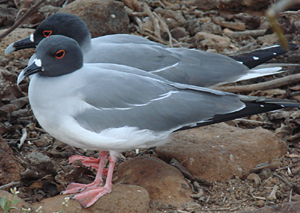 After a very calm night of sailing, the San Jose arrived at North Seymour just before dawn and anchored offshore. As the sun was rising, we boarded the dinghies and landed on the island. As usual, there were several Common Noddies feeding along the shore. At our landing site, there were several pairs of Swallow-tailed Gulls nesting in the lava ledges. A few steps up the trail we entered a Blue-footed Booby nesting area with numerous nests with eggs and young of all ages, including some that had fledged and were trying their wings around us. There were also several Magnificent Frigatebird nests and some of the males were displaying with their gular pouches inflated. Great Frigatebirds were also here and we were able to get close enough to see the eye ring of the females and the green sheen on the back of the males. There were numerous photo opportunities here as several of the nests had young in them.
After a very calm night of sailing, the San Jose arrived at North Seymour just before dawn and anchored offshore. As the sun was rising, we boarded the dinghies and landed on the island. As usual, there were several Common Noddies feeding along the shore. At our landing site, there were several pairs of Swallow-tailed Gulls nesting in the lava ledges. A few steps up the trail we entered a Blue-footed Booby nesting area with numerous nests with eggs and young of all ages, including some that had fledged and were trying their wings around us. There were also several Magnificent Frigatebird nests and some of the males were displaying with their gular pouches inflated. Great Frigatebirds were also here and we were able to get close enough to see the eye ring of the females and the green sheen on the back of the males. There were numerous photo opportunities here as several of the nests had young in them.
We walked a trail along the beach as the sky was now brilliant blue and crystal clear. Sea Lions, Mangrove Warblers, Galápagos Flycatchers, and a Small Ground-finch were seen as we walked the trails. By the time we reached the landing site, a large cruise ship had dropped what seemed like hundreds of passengers on shore. We were glad we chose to visit this magical place at first light and have it to ourselves.
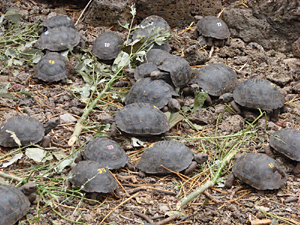 Back on the San Jose it was time to pack and say our goodbyes to our excellent crew. We loaded the zodiacs and went to the north side of Santa Cruz Island where we boarded a van to take us to Puerto Ayora on the south side of the island. We continued down to the Charles Darwin Research Station where we got out to tour the facility. We walked to the center where we saw exhibits describing the tortoise breeding efforts here and we toured the rearing pens as well as the holding pens for these awesome creatures. We stopped for a look at the famous Lonesome George and reviewed his story. We were able to walk in among the older tortoises that seemed indifferent to our presence.
Back on the San Jose it was time to pack and say our goodbyes to our excellent crew. We loaded the zodiacs and went to the north side of Santa Cruz Island where we boarded a van to take us to Puerto Ayora on the south side of the island. We continued down to the Charles Darwin Research Station where we got out to tour the facility. We walked to the center where we saw exhibits describing the tortoise breeding efforts here and we toured the rearing pens as well as the holding pens for these awesome creatures. We stopped for a look at the famous Lonesome George and reviewed his story. We were able to walk in among the older tortoises that seemed indifferent to our presence.
Later in the morning we checked into our lovely hotel in Puerto Ayora. After an excellent lunch in town we had the afternoon free to explore this bustling town. Some went to the fishing dock and watched Sea Lions fighting with Pelicans for fish scraps. Some went shopping along the main street of Puerto Ayora. Some enjoyed the scene at the waterfront of the town. We met again later at a restaurant for dinner and then returned to the hotel for our briefing on our excursions tomorrow.
Wednesday, July 25, 2007
This morning after breakfast, we met our bus and driver just outside the Hotel Red Booby. John noted how unique it was to see a brilliant Mangrove Finch on the street just outside the hotel. We loaded the van and headed into the highlands of Santa Cruz. We passed through the small town of Bellavista, picked up Efrén, our Galapagos National Park guide for the day, and continued on a dirt road ascending into the hills passing banana and coffee plantations, several Cattle Egrets, and a number of Smooth-billed Anis. The road was a bit muddy but our driver negotiated it well and soon we arrived at a parking area at the Galápagos National Park boundary. From here, we walked a trail through a Miconia forest up to the fern zone. The introduced and invasive Quinine Tree was prevalent here and Efrén explained how this tree was threatening the native vegetation. As we walked, a group of workers passed us heading into the forest to remove the Quinine.
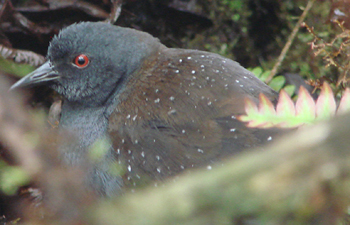 We walked up to an area called Media Luna toward Cerro Crocker, the highest point on Santa Cruz at 864 meters. There were the usual Small Ground-finches and a few Galápagos Flycatchers. The highlight of our walk up was two Short-eared Owls – the first one spotted by Gina as it flew over the hill above us. A second bird joined it and we all got great flight views of the birds. A little further up the trail, Efrén spotted one of the owls perched on a tall spike and now we had decent perching views of the bird. As we continued up the hill, the garua was getting harder and we all found our rain gear, which we hadn’t used at all on the trip until now. We were quiet, getting wet, and full of anticipation as our quarry here was the elusive Galápagos Rail, a very small, secretive bird now restricted to the Fern and Miconia Zones.
We walked up to an area called Media Luna toward Cerro Crocker, the highest point on Santa Cruz at 864 meters. There were the usual Small Ground-finches and a few Galápagos Flycatchers. The highlight of our walk up was two Short-eared Owls – the first one spotted by Gina as it flew over the hill above us. A second bird joined it and we all got great flight views of the birds. A little further up the trail, Efrén spotted one of the owls perched on a tall spike and now we had decent perching views of the bird. As we continued up the hill, the garua was getting harder and we all found our rain gear, which we hadn’t used at all on the trip until now. We were quiet, getting wet, and full of anticipation as our quarry here was the elusive Galápagos Rail, a very small, secretive bird now restricted to the Fern and Miconia Zones.
We stopped at an open area where the previous group had seen the rail two weeks earlier. In a few moments, we heard a rail right off the trail and were able to get great looks at it through the vegetation. A second bird joined it and the birds walked along the ground and we could see them well through small openings in the vegetation. At one point, on of the birds sat still and began preening, giving us all a chance to take in great views of this little gem. Fantastic!
The garua was lifting and we started back down the hill taking our time over the slippery terrain. Bob and John stayed behind to get better photos of the rail and after awhile we realized that they were not anywhere near us on the trail. Juan checked with Marcello to see what was happening and we got word that there were at least three owls near the trail. We made our way back up to find one young Short-eared Owl standing right in the middle of the trail. Another one was perched on one leg on top of a rise on the side of the trail and the adult flew by a few times, seeming to monitor the youngsters. The photo opp here was incredible and we spent a few minutes getting close shots of the beautiful young owls. The adult flew over and one youngster joined it. When the last owl heard them go, it took off as well, leaving us thrilled with our fantastic experience. But that wasn’t the last of the owls. Efrén had recently found the site of a roosting Barn Owl so he took us to a private farm and we followed the trail in to an area with some lava tubes. Juan and Efrén climbed down and in a few minutes located the owl so we all ambled down the trail into the massive lava tube to find the Barn Owl perched on the side wall. We walked through the tube to get a better angle on the bird and it barely reacted to our presence. Once again, the magic of the Galápagos was with us!
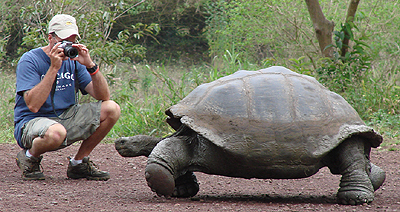 We moved on to a private ranch where we stopped for lunch while another garua blew through. We discovered a new finch – the Medium Table-Finch — which occurs only around the restaurant and is quick to jump on the table in between meal courses. Outside on the grounds were several Giant Tortoises with their attendant Anis or Cattle Egrets. They were an awesome sight and very photogenic, even though they would withdraw their heads and legs when you got close to them. Some of them made hissing sounds that sounded a bit like Darth Vader and a few did a display of raising and lowering the back end.
We moved on to a private ranch where we stopped for lunch while another garua blew through. We discovered a new finch – the Medium Table-Finch — which occurs only around the restaurant and is quick to jump on the table in between meal courses. Outside on the grounds were several Giant Tortoises with their attendant Anis or Cattle Egrets. They were an awesome sight and very photogenic, even though they would withdraw their heads and legs when you got close to them. Some of them made hissing sounds that sounded a bit like Darth Vader and a few did a display of raising and lowering the back end.
After lunch, we walked some trails on the ranch and enjoyed more looks at the many Giant Tortoises here. We passed a mud pond where several wallowed. As we were entering the forest, we could hear a wailing sound. Efrén called us back to see two tortoises copulating. Amazing!
We hiked through the forest which was very quiet until we reached a road where there were some tortoises and three burrows. We eventually reached our van and were happy to see it. When we attempted to drive out of the area, we encountered several “Tortoise Jams”. Our driver skillfully got around these gargantuan reptiles. The bus took us back to Puerto Ayora where we had a little more time to explore the shops and waterfront. Some of us wound up at The Rock and enjoyed a “Blue Booby Margarita” and toasted our wonderful day and fantastic trip. We had our final dinner in the Galápagos at Restaurant Hernan and said our goodbyes to our guide Efrén.
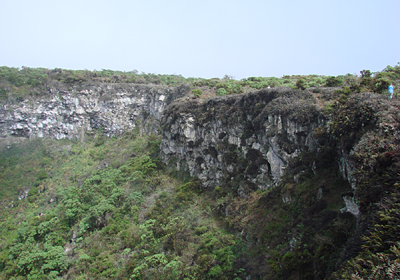 Thursday, July 26, 2007
Thursday, July 26, 2007
Today we had to say goodbye to the magical Galápagos Islands. We checked out of our hotel and headed north across Santa Cruz. We made a quick stop at the two pit craters called Los Gemelos for photos and continued on to the north end of the island. We crossed the canal to Baltra on the ferry and enjoyed our last looks at Blue-footed Boobies and Brown Noddies. A bus picked us up and took us to the airport for our flight back to the mainland. A few of us did some last-minute shopping before boarding the plane. Back in Quito, we enjoyed our last dinner of the trip at El Jardin. We toasted Juan, an excellent guide and host and planned our reunion for later in the summer.
Friday, July 27, 2007
John, Bob, Charlotte, and Gina were up and out early this morning for one last day of birding in the Andes. A little later on, the others headed for the airport for flights home.
This was a truly wonderful group of people and we shared many amazing experiences in the Galápagos. Special thanks to Juan and Billy for making the trip a huge success. We look forward to when all of our paths cross again!
